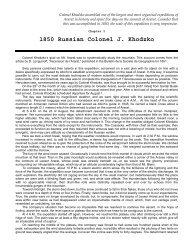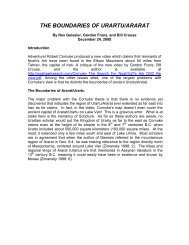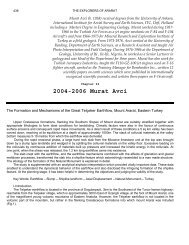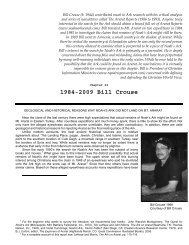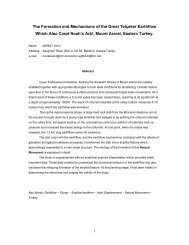1876 British Viscount & Ambassador James Bryce - Noah's Ark Search
1876 British Viscount & Ambassador James Bryce - Noah's Ark Search
1876 British Viscount & Ambassador James Bryce - Noah's Ark Search
You also want an ePaper? Increase the reach of your titles
YUMPU automatically turns print PDFs into web optimized ePapers that Google loves.
158 THE EXPLORERS OF ARARAT<br />
southeast. Towards the northeast, that is, on one of its long sides, it descends very abruptly towards the Aras plain,<br />
forming in places ranges of magnificent black precipice, capped with ice-beds many hundreds of feet in thickness, and<br />
pierced by a profound glen or chasm. On the opposite or southwest side the fall is somewhat less rapid; towards the<br />
southeast, where the peak faces Little Ararat, it is steep indeed, but in most parts not precipitous (this is the side up<br />
which I ascended); while towards the northwest the declivity is longer and more gentle, a succession of terraces,<br />
separated by moderately difficult slopes, falling away into an immense fan-shaped base, which spreads far into the<br />
Araxes plain. This is, therefore the side on which occur the only considerable fields of snow or rather névé (the others<br />
being too abrupt for much snow to lie), and it was by advancing over them that Parrot [1829 ascent] effected the first<br />
ascent of the mountain. The upper slopes, where not snow-covered, are extremely rough and broken, seamed by<br />
gullies, the larger of which are no doubt volcanic fissures, the smaller probably produced by winter storms, rising here<br />
and there into lofty towers and ridges of rock, and strewn with prodigious masses of loose stone, broken by the<br />
weather into wildly fantastic shapes. All this part, above 10,000 or 11,000 feet, is almost wholly bare of vegetation. The<br />
middle part of the declivity is somewhat less rugged, and the lowest slopes of all, by which the mass subsides into the<br />
plain, are singularly smooth and uniform. On the northeast side these basal slopes, as I may call them, are two. First<br />
comes one which rises from the Aras marshes at an angle of about 2½ degrees for some six miles, and then another,<br />
which rises for, say, four miles, at an angle of 4½ degrees. After this second, the steep part of the mountain begins. Its<br />
average angle on the northwest declivity is about 17 degrees, on the southeast 25 to 30 degrees.<br />
Both peaks are entirely composed of igneous rock, and there is no question that they belong to what may be<br />
called the grand volcanic system of Northwestern Asia, the main lines of whose action are indicated in a general way<br />
by the direction of the chief mountain chains, such direction being supposed to correspond to axes of elevation, or, as<br />
it is sometimes expressed, to lines of fissure. Along these lines of fissure, continuously or at intervals, the igneous<br />
masses forming the highest part of such chains were from time to time ejected. One such line, or perhaps more than<br />
one, is represented by the Caucasus, where, besides the granitic mountains on the axis, there are several<br />
comparatively modern volcanic summits, such as Elbruz, Kazbek, and Basarjusi. Another line of elevation, marked by<br />
volcanic outbursts, appears in the northeastern ranges of Taurus; another in the range dividing the upper valleys of the<br />
Kur and Aras. Still nearer to Ararat, the great mass of Ala Göz, on the north, and the continuation of that mass to the<br />
east and southeast in the mountains that surround the Goktcha lake, are all volcanic, composed chiefly of trachyte<br />
rock. The valley of the Aras itself is filled by recent alluvial deposits, out of which rise isolated palæozoic hills<br />
composed of carboniferous limestone or Devonian strata, which appear again farther to the south, in the hills through<br />
which the Aras takes its way to Nakhitchevan and the Persian border; while farther to the south and west, newer<br />
sedimentary rocks range southwards, pierced here and there by the volcanic outbursts which reach as far as Lake<br />
Van.<br />
The only geologist of eminence who has carefully examined Ararat is Hermann Abich [1845 expedition with<br />
Armenian guide and engineer/officer General Chodzko [Khodzko] from the Georgian capital of Tiflis [later Tiblisi]], now<br />
one of the patriarchs of the science; and probably the best thing I can do is to abridge his view of its structure and<br />
history, so far as I can gather it from the various papers, which he has contributed, to different scientific journals. He<br />
holds the inner and original part of the mass to be composed of trachyte and trachytic tuffs, poured out at a<br />
comparatively early period in dome-shaped hills, three of which, placed along a line of fissure running nearly northwest<br />
and southeast, were Little Ararat, Great Ararat, and the rounded plateau called, from a small pond or pool upon it<br />
(ghöll = lake, in Tatar), Kip Ghöll, which lies about four miles northwest by west of the top of Great Ararat. The eruptive<br />
forces which raised these hills having, after an interval of quiescence, resumed their activity in comparatively recent<br />
times, probably in what we call the pleiocene age, violent splitting and bursting of the trachytic rocks went on, mainly<br />
along the old lines of fissure, and vast quantities of lava of a doleritic or basaltic character were poured out from<br />
various points along these fissures. The pressing-up from beneath of the edges of the fissures gave to the summits of<br />
both Great and Little Ararat their present form; no eruptions taking place from the actual tops, although some of the<br />
fissure-vents which discharged streams of doleritic lava were not far below these summits, while a number of minor<br />
cones were raised and craters formed along the sides of the mountain, especially to the southeast of Great Ararat, and<br />
on Kip Ghöll, where several large and well-marked crateriform hollows may be still made out. Along with this splitting,<br />
there went on a process of elevation, by which the southern edge of one huge cleft was raised to be the present<br />
summit of Great Ararat, while its other side remained at, or sank to, a much lower level; other rifts were also formed at<br />
right angles to the principal axis, one of which was the origin of the remarkable chasm on the northeast side of the<br />
mountain, which bears much similarity to the famous Val del Bove on Etna. Its present shape and dimensions—it is<br />
nearly 9000 feet deep, and surrounded by monstrous precipices—are probably, like those of the Sicilian valley, due to<br />
subsequent erosion; but there may well have been eruptions from it in some earlier stage. A somewhat similar, but<br />
smaller, chasm penetrates deep into the mountain on the opposite or southwestern side.<br />
According to this theory, there never was a great central crater at the summit of either Great or Little Ararat. The<br />
forms of those two peaks are due to the elevating and rending forces which, operating on pre-existing trachytic<br />
masses, squeezed up the edges of the clefts they opened into comparatively sharp points, while prodigious and longcontinued<br />
eruptions sometimes from these clefts, sometimes from cones of eruption built up round the principal orifices<br />
along their line, increased the external volume of the mountain, and in the case of Great Ararat turned it from a<br />
comparatively sharp cone, similar to Little Ararat, into the broad-shouldered, grandly buttressed mass which it now



